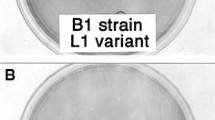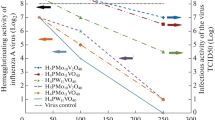Summary
For three reference strains (KBSH, TVX, and Lu III) of the parvoviruses isolated from permanent human cell lines the morphological and physicochemical properties were determined and yielded the following results:
-
1.
The cubic virus particles had a mean diameter of 19–21 mμ. Their capsid is probably constructed from 32 capsomeres and fits the symmetrical requirements of a pentakis dodekahedron.
-
2.
In CsCl the complete infective viruses showed a buoyant density of 1.395 g/ml whereas empty capsids and other hemagglutinating breakdown products banded around 1.31 g/ml. A further virus peak associated with both infective and hemagglutinating properties could be detected at a medium density of 1.35 g/ml.
-
3.
The sedimentation coefficient of complete KBSH-virus was determined to be 105±10 S and hemagglutinating fractions of the agent with a buoyant density around 1.31 g/ml sedimented at 72 S.
-
4.
According to the successful incorporation of3H-thymidine, the inhibition of multiplication by IUDR, and the behaviour during acridine orange staining the viruses contain DNA of single stranded configuration.
-
5.
The viruses proved resistant to the action of ether, chloroform, Freon, Nadeoxycholate, and enzymes such as trypsin, pepsin, papain, RNase, and DNase. Heating of purified preparations to 75 °C for 1 hour also reduced infectivity and hemagglutination titers only a houndred-fold.
When compared with the physicochemical characteristics of well accepted and of some candidate members of the parvovirus group these data clearly allow the classification of the isolated agents into this new viral grouping.
Similar content being viewed by others
References
Binn, L. N., E. C. Lazar, G. A. Eddy, andM. Kajaima: Recovery and characterization of a minute virus of canines. Infect. Immun,1, 503–508 (1970).
Cartwright, S. F., M. Lukas, andR. A. Huck: A small hemagglutinating porcine DNA virus. I. Isolation and properties. J. comp. Path.79, 371–377 (1969).
Cochran, K. W., andF. E. Payne: Susceptibility of a strain of rat virus to Statolon and other virus inhibitors. Proc. Soc. exp. Biol. (N.Y.)115, 471–474 (1964).
Crawford, L. V.: A minute virus of mice. Virology29, 605–612 (1966).
Crawford, L. V., E. A. Follet, M. G. Burdon, andD. J. McGeoch: The DNA of a minute virus of mice. J. gen. Virol.4, 37–46 (1969).
Greene, E. L.: Ph. D. Thesis. Ithaka, New York: Cornell Univ., 1964.
Greene, E. L.: Physical and chemical properties of H-1 virus. I. pH and heat stability of the hemagglutinating property. Proc. Soc. exp. Biol. (N.Y.)118, 973–975 (1965).
Hallauer, C., undG. Kronauer: Nachweis eines nicht identifizierten Hämagglutinins in menschlichen Tumor-Zellstämmen. Arch. ges. Virusforsch.11, 754–756 (1962).
Hallauer, C., andG. Kronauer: Extraction of cell-associated virus without damage of the culture. Arch. ges. Virusforsch.15, 434–440 (1965).
Hallauer, C., G. Kronauer, andG. Siegl: Parvoviruses as contaminants of permanent human, cell lines I. Virus isolations from 1960–1970. Arch. ges. Virusforsch.35, 80–90 (1971).
Hoggan, M. D., N. R., Blacklow, andW. P. Rowe: Studies of small DNA viruses found in various adenovirus preparations: Physical, biological and immunological characteristics. Proc. nat. Acad. Sci. (Wash.)55, 1467–1474 (1966).
Horzinek, M., M. Mussgay, J. Maess undK. Petzoldt: Nachweis dreier Virusarten (Schweinepest-, Adeno-. Picodna-Virus) in einem als cytopathogen bezeichneten Schweinepest-Virusstamm. Arch. ges. Virusforsch.21, 98–112 (1967).
Horzinek, M.: Characterization of hog cholera virus. II. Determination of sedimentation coefficient. Arch. ges. Virusforsch.21, 447–453 (1967).
Jamison, R. M., andH. D. Mayor: Acridine orange staining of purified rat virus strain X-14. J. Bact.90, 1486–1488 (1965).
Johnson, R. H., andJ. G. Cruickshank: Problems in classifications of feline panleucopenia virus. Nature (Lond.)212, 622–623 (1966).
Karasaki, S.: Size and ultrastructure of the H-viruses as determined with the use of specific antibodies. J. Ultrastruct. Res.16, 109–122 (1966).
Kilham, L., andL. J. Olivier: A latent virus of rats isolated in tissue culture. Virology7, 428–437 (1959).
Kozinsky, A. W., andW. Szybalsky: Dispersive transfer of the parental DNA molecule to the progeny of phage ø X 174. Virology9, 260–274 (1959).
Mayor, H. D., andA. R. Diwan: Studies on acridine orange staining of two purified RNA viruses: poliovirus and tobacco mosaic virus. Virology14, 74–82 (1961).
Mayor, H. D., andN. O. Hill: Acridine orange staining of a single stranded DNA-bacteriophage. Virology14, 264–266 (1961).
Mayor, H. D., andE. L. Jordan: Electron microscopic study of the rodent “picodnavirus” X-14. Exp. molec. Path.5, 580–589 (1966).
Mayor, H. D., andJ. L. Melnick: Small deoxyribonucleic acid containing viruses (Picodnavirus group). Nature (Lond.)210, 331–332 (1966).
Mayr, A., P. A. Bachmann, G. Siegl, H. Mahnel, andB. E. Sheffy: Characterization of a small porcine DNA virus. Arch. ges. Virusforsch.25, 38–51 (1968).
McGeoch, D. J., L. V. Crawford, andE. A. C. Follett: The DNA of three parvoviruses. J. gen. Virol.6, 33–40 (1970).
Parks, W. P., J. L. Melnick, R. Rongey, andH. D. Mayor: Physical assay and growthcycle studies of a defective adenosatellite virus. J. Virol.1, 171–180 (1967).
Payne, F. E., T. F. Beals, andR. E. Preston: Morphology of a small DNA-virus. Virology23, 109–113 (1964).
Polson, A., andM. H. V. Van Regenmortel: A new method for determination of sedimentation constants of viruses. Virology15, 397–403 (1961).
Robinson, D. M., andF. M. Hetrick: Single-stranded-DNA from Kilham rat virus. J. gen. Virol.4, 269–281 (1969).
Schaffer, F. L., andC. E. Schwerdt: Purification and properties of poliovirus. Advanc. Virus Res.6, 159–204 (1959).
Siegl, G., andE. E. A. Hahn: A paramyxovirus-like virus isolated from pemphigus-disease in man. Electronoptical and buoyant density studies. Arch. ges. Virusforsch.28, 41–50 (1969).
Siegl, G.: Parvoviruses as contaminants of permanent human cell lines. V. The nucleic acid of KBSH-virus. Arch. ges. Virusforsch. (1971) in press.
Sinsheimer, E. L.: A single stranded deoxyribonucleic acid from bacteriophage ø X 174. J. molec. Biol.1, 34–53 (1959).
Smith, K. O., W. D. Gehle, andJ. F. Thiel: Properties of a small virus associated with adenovirus type 4. J. Immunol.97, 754–766 (1966).
Spahn, G. J., S. B. Mohanty, andF. M. Hetrick: Characteristics of hemadsorbing enteric (HADEN) virus. Canad. J. Microbiol.12, 653–661 (1966).
Storz, J., andG. S. Warren: Effect of antimetabolites and actinomycin D on the replication of HADEN, a bovine parvovirus. Arch. ges. Virusforsch.30, 271–274 (1970).
Toolan, H. W., E. L. Sounders, E. L. Greene, andD. P. A. Fabricio: Further studies on the electron microscopy of the H-1 virus. Virology22, 286–288 (1964).
Toolan, H. W.: A virus associated with transplantable human tumors. Bull. N.Y. Acad. Med.37, 305–310 (1961).
Toolan, H. W.: The picodna viruses: H, RV and AAV. Int. Rev. exp. Path.6, 135–180 (1968).
Tromans, W., W. J. Horne, andR. W. Horne: The structure of bacteriophage ø X 174. Virology15, 1–7 (1961).
Vasquez, C., andC. Brailovsky: Purification and fine structure of Kilham's rat virus. Exp. molec. Path.4, 130–140 (1965).
Author information
Authors and Affiliations
Rights and permissions
About this article
Cite this article
Siegl, G., Hallauer, C., Novak, A. et al. Parvoviruses as contaminants of permanent human cell lines. Archiv f Virusforschung 35, 91–103 (1971). https://doi.org/10.1007/BF01249756
Received:
Issue Date:
DOI: https://doi.org/10.1007/BF01249756




